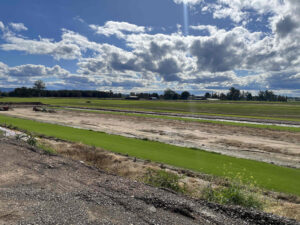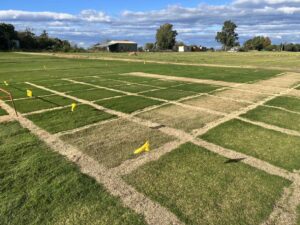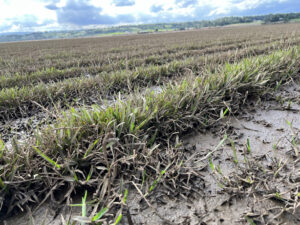
Turf farms to build better resilience
By Matthew Lunn
The record-breaking storms and flooding that occurred in parts of NSW, and which started in February 2022, has had a significant impact on communities. Lives have been lost and many people were forced to evacuate as the severe weather events caused extensive damage to residential properties, businesses, public infrastructure, agriculture, and the environment.
It is estimated that 45 turf farms were impacted by the floods, with losses reaching around $140,000,000 for the turf industry.
The Hawkesbury Valley, the area west of Sydney, and the NSW Mid-North Coast, were the hardest hit, with over 2,800 hectares of turf production severely impacted.

Floods are not new to the turf industry, but until last year’s flood in March, there hasn’t been a major flood on the Hawkesbury-Nepean for more than 30 years, with the last comparable one occurring in 1990.
Whilst all floods are incredibly damaging to turf farms, having one this late in the growing season is somewhat rare, with a much longer-lasting effect.
Silt, sadly, is a result of all floods, and it can take months of good growing weather to recover crops, even if only partially affected by the impact of silt. The other major floods in the past 35 years came much earlier in the season. In 1986, they came in August; in 1990,February; and in 2016, they occurred in September.
A flood in late March means that silt-covered turf must enter winter and wait for more than six months for favourable growing conditions to return. What this means, in short, is root rot, very heavy and brittle turf for months with huge increases in wastage and transport costs due to weight increases, for months to come. In a normal year, this causes a turf shortage.

The impact of production was felt right across the industry in NSW, and growers not only had to deal with the loss of income from turf sales but faced establishment costs for earthworks, the replanting of a new crop and, in some cases, had to deal with erosion to riverbanks, drainage systems blocking and failing, pump sites being washed away, broken fences, damaged irrigation infrastructure, damage to sheds, offices, cool rooms, and loss of machinery.
With many turf suppliers impacted by the floods, supply was significantly reduced in the regions affected.
On top of this, some growers lost production not only in 2022 but also in 2023 due to the continuation of inclement weather and complications in the availability of earthmoving services to re-level paddocks.
Support and help for those impacted has thankfully been at hand through the $3.2 million Early Needs Recovery Program. This supports industry grants and is part of the $150 million primary industry support package that is co-funded 50/50 by the Australian and NSW governments under the Disaster Recovery Funding Arrangements (DRFA).This program is designed to support recovery, rebuilding, and resilience efforts for producers of agricultural goods in the most heavily impacted industries
In February 2023, Turf Australia was awarded a grant through this program in conjunction with Local Land Services NSW to look at improved turf management strategies to increase speedier recovery of paddocks, and also to tackle better business resilience.

To achieve this, a key component of the work by Turf Australia and Project Agronomist Peter McMaugh AM, is the conducting of herbicide trials post flooding at a number of turf farms across the Hawkesbury, to determine improved techniques to eradicate invasive weeds with broadacre herbicides. The key aim will be to determine not only cost-effective weed eradication turf farm practices but for farmers to work towards more sustainable environmental practices in managing their paddocks.
The second part of the project will see growers being educated through the Business Resilience Sustainability Tool which will assist them in clearly understanding recovery costs associated with natural disasters that will, in turn, build better business resilience.
Turf farms impacted by the floods still have a long way to recovery but it is hoped through the project work of Turf Australia, farmers can be provided with the right tools to tackle the next natural disaster that mother nature throws at them.
Matthew Lunn
CEO Turf Australia
T. 0410 714 207
Matt.lunn@turfaustralia.com.au
Main photo: Trials team (Image: Finn Coleman, Hawkesbury Gazette)
